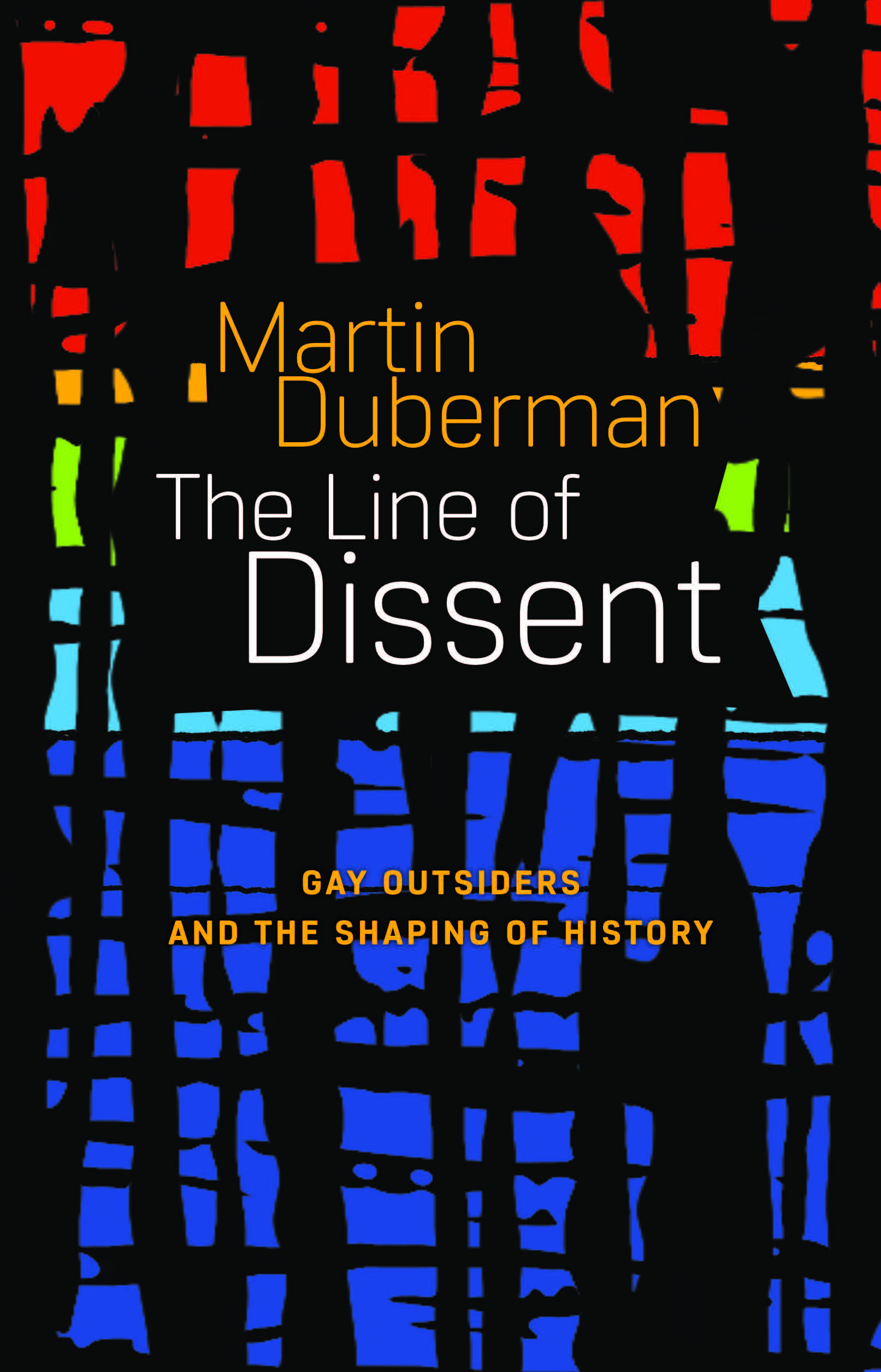The Line of Dissent
The Line of Dissent
Gay Outsiders and the Shaping of History
By Martin Duberman
Edited By Richard Schneider Jr.
THE TITLE OF THIS COLLECTION, The Line of Dissent, suggests a common denominator for a truly diverse group of individuals — beyond the fact that all were amazing people who lived extraordinary lives. They were trailblazers who forged new ways of thinking or being, and all made major contributions to LGBT life and culture.
These essays (with a few exceptions) first appeared in The G&LR — the first, in 1997, an in-depth profile of Edward Sagarin, author of The Homosexual in America (1951), dubbed “the Father of the Homophile Movement.” The latest, from 2022, provides new insights into the work of Alfred Kinsey, who pretty much invented the field of sex research, and his acolyte C.A. Tripp, author of the explosive 1975 book The Homosexual Matrix.
Between these scholarly bookends are activists, poets, artists, and daredevils. A three-part series on impresario Lincoln Kirstein reveals how he brought the art of ballet to America. Several profiles can be found at the intersection of the LGBT struggle and leftist politics: activist Barbara Deming and her strategy of “direct action nonviolence”; Sylvia Rivera, who sparked the transgender revolution decades before her time; and bisexual Andrea Dworkin, the radical second wave feminist. Another group includes visual artists such as painter Robert Rauschenberg and designer Ed Wormley, and poets such as W. H. Auden and Black activist Essex Hemphill. There’s even a chapter on lesbian speedboat racer Joe Carstairs, who burst all kinds of barriers when she won major trophies in the 1920s.
In short, it’s a wild ride covering a breathtaking swath of LGBT history, all brought to you in Martin Duberman’s informative, easygoing style of writing.
 MARTIN DUBERMAN, Distinguished Professor of History Emeritus at CUNY, is the author of some two dozen books, including Haymarket, Jews, Queers, Germans, and, most recently, his memoir Reaching Ninety. He is the recipient of numerous awards, including the Bancroft Prize, the Vernon Rice Drama Desk Award, three Lambda Literary Awards, a special award from the National Academy of Arts and Letters for his contributions to literature, the 2007 lifetime achievement award from the American Historical Association, and the Whitehead Award for Lifetime Achievement. He has been a finalist for both the National Book Award and the Pulitzer Prize, and has received honorary degrees from Amherst College and Columbia University. He lives in New York City.
MARTIN DUBERMAN, Distinguished Professor of History Emeritus at CUNY, is the author of some two dozen books, including Haymarket, Jews, Queers, Germans, and, most recently, his memoir Reaching Ninety. He is the recipient of numerous awards, including the Bancroft Prize, the Vernon Rice Drama Desk Award, three Lambda Literary Awards, a special award from the National Academy of Arts and Letters for his contributions to literature, the 2007 lifetime achievement award from the American Historical Association, and the Whitehead Award for Lifetime Achievement. He has been a finalist for both the National Book Award and the Pulitzer Prize, and has received honorary degrees from Amherst College and Columbia University. He lives in New York City.
Introduction
Martin Duberman’s first contribution to The G&LR—The Gay & Lesbian Review—was in 1994, the year of our founding, which was also the 25th anniversary of the Stonewall Riots. His book on the Riots and their aftermath had recently been published, and he was kind enough to sit with me for an interview for our Stonewall issue. The resulting discussion, as insightful as it was, does not appear in this book, which includes twenty featured essays that he contributed over the years.
The title of this collection, “The Line of Dissent,” suggests a common denominator to unite an unruly set of individuals—beyond the fact that all were gifted people who did great things. They were trailblazers who took on the Establishment, forging new ways of thinking and being while making important contributions to LGBTQ+ life and culture.
The first of these essays to appear, in 1997, is an in-depth profile of Edward Sagarin, author of The Homosexual in America (1951), a first-of-a- kind sociological study that earned him the epithet “Father of the Homophile Movement.” The latest, from 2022, offers new insights into the work of sex research pioneer Alfred Kinsey, notably on his findings around homosexual behavior, plus an inside look at the work of Kinsey’s acolyte C. A. Tripp, author of the explosive 1975 book The Homosexual Matrix.
Between these scholarly bookends came profiles of activists, poets, artists,
and daredevils. A three-part series on impresario Lincoln Kirstein details how he brought ballet theater to America—but only after bringing to these shores choreographer George Balanchine, with whom he founded the New York City Ballet. An in-depth look of the Black poet Essex Hemphill examines both his radical poetry and his political activism during the AIDS crisis. And while British poet W. H. Auden was quite cautious, his lifelong partner Chester Kallman, a poet in his own right, was outspokenly gay in his poetry and his public life.
Two of Duberman’s lifelong interests are the history of the American Left and that of the LGBTQ+ movement; several profiles can be found where these two concerns intersect. Barbara Deming’s involvement in the gay rights movement of the 1960s and ’70s was of a piece with her antiwar activism, radical feminism, and anti-racism. Sylvia “Ray” Rivera gave a speech in 1973 that set the stage for the transgender revolution years before it became a national cause. Andrea Dworkin, the controversial radical second wave feminist, was no less strenuous in her opposition to the Vietnam War.
Well outside the political arena are several profiles in dissent in ostensibly nonpolitical endeavors. Modernist artist Robert Rauschenberg is described as a “reluctant activist” who took on the art establishment by encoding his work with homoerotic imagery. Another such activist was Mary Meigs, also a Modernist-era painter, but it’s her four memoirs about her life with Barbara Deming that reveal the reality of lesbian life during their era. There’s even a speedboat racer in the mix, Joe Carstairs, a gender-bending woman who burst all kinds of barriers when she won major trophies in the 1920s.
Like Carstairs, The Line of Dissent moves quickly through a wide expanse, stopping at key moments in LGBTQ+ history to focus on a number of creative individuals who challenged the status quo and opened new channels of understanding and discovery for the generations that came next.
—Richard Schneider Jr., Editor-in-Chief, The G&LR
Contents
Introduction…………………………………………………………………………………………………………..ix
Preface……………………………………………………………………………………………………………………..xi
1. Edward Sagarin: “Father” of the Homophile Movement……………………1
FROM G&LR, Fall 1997
2. Essex Hemphill and Anti-Black Racism………………………………………………..33
FROM A Saving Remnant (2011, The New Press)
3. Sylvia “Ray” Rivera: Before Transgender ……………………………………………57
FROM Stonewall (1993, Dutton)
4. Barbara Deming and Direct Action Nonviolence………………………………79
FROM G&LR, May-June 2020
5. Alfred Kinsey and C. A. Tripp……………………………………………………………………96
Part I: When Kinsey Met Tripp …………………………………………………………………..96
Part II: Tripp’s Homosexual Matrix Deconstructed………………………………. 104
Part III: In Defense of Kinsey………………………………………………………………….. 115
COMPLILED from G&LR, Nov.-Dec. 2021 and Jan.-Feb. 2022
6. Lincoln Kirstein…………………………………………………………………………………………. 121
Part I: Friends and Lovers…………………………………………………………………………. 121
Part II: Balanchine in the U.S. …………………………………………………………………… 132
Part III: Lincoln Kirstein: Rivals and Idols …………………………………………….. 157
COMPILED from G&LR, Jan.-Feb, May-June, and July-Aug. 2017
7. W. H. Auden and Chester Kallman: Separately Together……………. 165
COMPILED from G&LR, Jan.-Feb. 2018
8. Andrea Dworkin: The Woman I Knew ………………………………………………. 176
FROM G&LR, Sept.-Oct. 2019
9. The Two Eds: A Fifty-Year Love Story…………………………………………………. 189
(co-authored with Michael Kammen)
FROM G&LR, Jan.-Feb. 2020
10. The Artist as (Reluctant) Activist………………………………………………………… 204
Part I: Mary Meigs……………………………………………………………………………………….. 204
FROM G&LR, Sept.-Oct. 2021
Part II: The Case of Robert Rauschenberg …………………………………………….. 214
FROM The New York Times, Sept. 7, 1997
11.Joe Carstairs: Her Own Authority………………………………………………………… 219
FROM G&LR, July-Aug. 2022
12.Queers For Economic Justice………………………………………………………………… 227
ADAPTED from Waiting to Land (2009, The New Press)
Coda I: Outsiders and the Shaping of History…………………………………………….. 236
Coda II: Who Are The Patriots?……………………………………………………………………… 243


